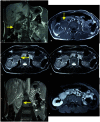Unicentric Castleman's disease of abdomen
- PMID: 23705043
- PMCID: PMC3661424
- DOI: 10.3941/jrcr.v7i3.1031
Unicentric Castleman's disease of abdomen
Abstract
Castleman's disease (CD) is a rare lymphoproliferative disease of uncertain etiology that affects lymph nodes. CD can be classified as a) unicentric vs. multicentric, based on clinical and radiological findings, b) hyaline vascular (80-90%) vs. plasmacytic (10-20%) vs. mixed cellularity variety based on histopathology. Unicentric disease is more common in the 3rd and 4th decade, whereas the multicentric form is more common in the 5th and 6th decade with no sex predilection. HIV seropositive individuals appear to be at an increased risk for multicentric castleman's disease (MCD) at a younger age due to the increased incidence of HHV- 8 infection. Diagnosis is usually based on histopathology features as imaging features show considerable overlap, thus posing diagnostic difficulties. Overall prognosis is good, particularly in the unicentric variety of disease. We have presented a case of the unicentric CD in a 40 year old male patient having abdominal pain and hematuria as chief complaints.
Keywords: CT; Castleman's Disease; Computed Tomography; MRI; Magnetic Resonance Imaging; idiopathic; unicentric.
Figures



References
-
- Castleman B, Iverson I, Menendez VP. Localized mediastinal lymph-node hyperplasia resembling thymoma. Cancer. 1956;9:822–830. - PubMed
-
- Keller AR, Hochholzer L, Castleman B. Hyaline-vascular and plasma-cell types of giant node hyperplasia of the mediastinium and other locations. Cancer. 1972;29:670–83. - PubMed
-
- Martinez S, Mcadams HP, Erasmus JJ. Mediastinum. In: Haaga JR, editor. CT and MRI of whole body. 5th ed. Mosby; 2009. pp. 1016–17.
-
- Gaba AR, Stein RS, Sweet DL, Variakojis D. Multicentric giant lymph node hyperplasia. Am J Clin Pathol. 1978;69:86–90. - PubMed
-
- Herrada J, Cabanillas F, Rice L, Manning J, Pugh W. The clinical behaviour of localised and multicentric castleman's disease. Ann intern Med. 1998;128:657–62. - PubMed
Publication types
MeSH terms
LinkOut - more resources
Full Text Sources
Other Literature Sources

